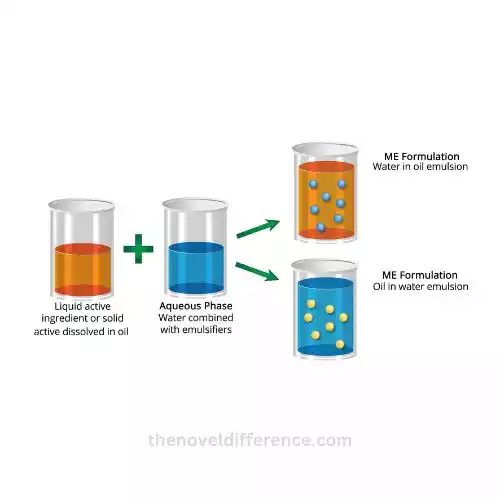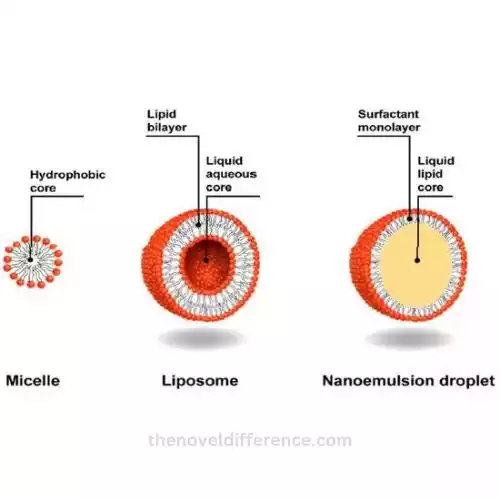Microemulsions and Nanoemulsions differ primarily in that microemulsions have thermodynamic stability while nanoemulsions don’t. Microemulsion and Nanoemulsion are two forms of emulsions. An emulsion is a fine dispersion that contains tiny droplets from one liquid in a second, which is neither miscible nor soluble.
A mixture of two liquids that are not miscible is an emulsion. A colloid can be thought of as a type of emulsion. The terms colloid and emulsion are often interchangeable. However, the term emulsion is the mixture of liquids that forms a colloid.
Why it is important to understand nanoemulsions and microemulsions
Formulation design: understanding the differences between Microemulsion and Nanoemulsion can assist formulators and researchers in selecting the most appropriate emulsion type for a specific application.
Nanoemulsions tend to be more stable than their microemulsion counterparts, making them suitable for drug delivery systems requiring long-term stability.
Property and behavior: microemulsions, nanoemulsions, and their properties can have different behavior depending on the application. Understanding these differences will help researchers and formulators to optimize their formulations.
Compliance with regulatory requirements: different regulatory agencies require different particle sizes in emulsions. Understanding the difference between nanoemulsions and microemulsions can help formulators make sure that their products comply with regulatory requirements.
Labeling of products: the particle size can influence their labeling or marketing claims. A product containing a nanoemulsion could be marketed under the name “nano”, which may have an impact on consumer perception.
Understanding the differences between Microemulsion and Nanoemulsion is crucial for formula design, optimizing behavior and properties, regulatory compliance, and product labeling.
Microemulsion definition and characteristics
A microemulsion is a colloidal dispersion made up of two liquids that are not compatible (oil and water), stabilized with a surfactant. Microemulsions form spontaneously and are thermodynamically stable. The droplet size is small, usually between 10 and 100 nanometers.

Clarity: microemulsions, due to their uniform dispersion and small droplet size, are usually transparent or translucent.
Stability: microemulsions do not undergo phase separation and are thermodynamically stable. They also resist coalescence and sedimentation.
Low interfacial pressure: microemulsions are characterized by a low level of interfacial friction between the oil phase and the water phase, which allows for the stabilization and formation of small droplets. Due to their composition and structure, microemulsions have a high solubilization capability.
Properties that can be adjusted: microemulsions’ properties can be altered by changing the composition, including the type of surfactant and the concentration of oil and water. Many applications use microemulsions, such as drug delivery, oil recovery, food processing, and cosmetics.
Nanoemulsion definition and characteristics
Nanoemulsions are colloidal dispersions consisting of oil and water, stabilized with a surfactant. They have very small droplet sizes ranging between 20 and 200 nanometers. Nanoemulsions require energy to maintain and form their small droplet size.

Nanoemulsions tend to be transparent because of their small droplets and uniform distribution.
High stability: nanoemulsions have high kinetic stability and don’t phase separately over time. They are resistant to both coalescence and segregation. Nanoemulsions are characterized by a large surface area interfacial between the oil phase and the water phase, which allows for the delivery and solubilization of hydrophobic compounds and hydrophilic substances.
Properties that can be adjusted: nanoemulsions’ properties can be altered by changing the composition, including the type of surfactant and the concentration of oil and water. Bioavailability is improved: nanoemulsions are known to increase the bioavailability of drugs and nutraceuticals, due to their smaller droplet size and higher solubilization capability.
Nanoemulsions are used in many applications, including drug delivery, food processing, personal products, agricultural formulations, and the production of beverages and foods.
Key comparison chart of Microemulsion and Nanoemulsion
Creating a comprehensive chart comparing microemulsions and nanoemulsions can help in understanding the key differences between these two types of emulsions.
Below is a fancy comparison chart that highlights the fundamental distinctions between microemulsions and nanoemulsions:
| Properties | Microemulsion | Nanoemulsion |
|---|---|---|
| Particle Size | 100-1000 nm | 20-200 nm |
| Appearance | Translucent or clear | Translucent or clear |
| Stability | Relatively stable | More stable, increased kinetic stability |
| Transparency | Less transparent compared to nanoemulsions | More transparent compared to microemulsions |
| Phase Behavior | Thermodynamically stable | Thermodynamically unstable |
| Manufacturing Process | Require more energy for production | Can be produced using low-energy methods |
| Applications | Cosmetics, pharmaceuticals, enhanced oil recovery | Pharmaceuticals, food, beverages, cosmetics |
| Solubilization | Limited solubilization capability | Enhanced solubilization capability |
| Delivery Efficiency | Relatively lower delivery efficiency | Higher delivery efficiency |
| Toxicity | Generally considered safe at appropriate levels | Generally considered safe at appropriate levels |
| Shelf Life | Relatively shorter shelf life compared to nanoemulsions | Longer shelf life compared to microemulsions |
This chart serves as a basic guide to differentiate between microemulsions and nanoemulsions, considering their properties, applications, and other key factors.
What are the similarities between microemulsion and nanoemulsion?
Microemulsions and nanoemulsions share some similarities due to their emulsion nature, but they also have distinct differences.
Here are the key similarities between microemulsions and nanoemulsions:
- Emulsion Nature: Both microemulsions and nanoemulsions are types of emulsions, which means they consist of two immiscible liquids (usually oil and water) stabilized by an emulsifying agent. The emulsifying agent helps to prevent the separation of the two phases.
- Small Particle Sizes: Both microemulsions and nanoemulsions contain very small droplets or particles. While the sizes can vary, they are generally much smaller than those found in traditional macroemulsions.
- Enhanced Solubilization: Both types of emulsions are capable of enhancing the solubility of hydrophobic (water-insoluble) substances in the aqueous phase and hydrophilic (oil-insoluble) substances in the oil phase. This property makes them useful for encapsulating and delivering various active ingredients.
- Increased Surface Area: The small particle sizes in both microemulsions and nanoemulsions result in a large interfacial area between the oil and water phases, promoting efficient mixing and mass transfer. This is beneficial for applications involving the release of active compounds.
- Transparency: Both microemulsions and nanoemulsions can appear translucent or clear, which is advantageous for applications like cosmetics, pharmaceuticals, and certain food products.
- Applications: Microemulsions and nanoemulsions find applications in similar industries, such as pharmaceuticals, cosmetics, food and beverage, and enhanced oil recovery.
Benefits of Microemulsions and Nanoemulsions
Unlocking the Power of Tiny Drops: Benefits of Microemulsions and Nanoemulsions
Microemulsions and nanoemulsions may sound complex, but their advantages are quite straightforward. These tiny droplets pack a punch in various industries, from pharmaceuticals to cosmetics, and even food.
Here’s why they matter:
1. Enhanced Solubility: Microemulsions and nanoemulsions make it easier to dissolve substances that don’t readily mix with each other. This improves the delivery of drugs, nutrients, or flavor in various products.
2. Improved Absorption: Smaller droplets mean increased surface area. This leads to better absorption of substances, such as drugs or skincare ingredients, making treatments more effective.
3. Stability: These emulsions are like stable, long-lasting friendships. They don’t easily separate or break down, ensuring that the products they’re in have a longer shelf life.
4. Transparency: Unlike conventional emulsions, microemulsions and nanoemulsions often appear clear, making them ideal for products like clear beverages, skincare serums, and more.
5. Taste and Texture: In the food industry, these emulsions can enhance the taste, texture, and mouthfeel of products, making your favorite treats even more enjoyable.
6. Controlled Release: They allow for controlled release of active ingredients, which is especially valuable in pharmaceuticals, where precise dosages and timing matter.
Microemulsions and nanoemulsions are the tiny superheroes of the chemistry world, making products work better and last longer. Their applications are far-reaching, benefiting everything from your medicine cabinet to your dining table.
What are the harmful effects of Microemulsion and Nanoemulsion?
Microemulsions and nanoemulsions are tiny liquid droplets dispersed in another liquid, often used in various industries, including food, cosmetics, and pharmaceuticals.
While they offer numerous advantages, it’s important to be aware of potential harmful effects:
1. Skin Irritation: In some cosmetic products, microemulsions or nanoemulsions may cause skin irritation, especially if the droplets contain certain chemicals or allergens. Always check product labels for potential irritants.
2. Allergic Reactions: Some individuals may be sensitive to the ingredients in microemulsions or nanoemulsions, leading to allergic reactions. If you have known allergies, be cautious when using products that contain these emulsions.
3. Ingestion Risks: In the food industry, if microemulsions or nanoemulsions are not properly formulated or contain unsafe ingredients, there’s a risk of consuming harmful substances. Always choose products from reputable sources.
4. Toxic Ingredients: Depending on the formulation, these emulsions may contain substances that can be harmful when ingested, inhaled, or applied to the skin. Carefully read labels and avoid products with potentially toxic components.
5. Environmental Impact: Improper disposal of products containing these emulsions can harm the environment. Dispose of such products as per local regulations.
Microemulsions and nanoemulsions are safe when used in accordance with product instructions and from reputable sources. It’s crucial to be aware of potential risks, especially if you have allergies or sensitivities, and to choose products carefully.
Used in a variety of applications Microemulsion and Nanoemulsion
Microemulsions and nanoemulsions are versatile and find applications in a wide range of industries. These tiny liquid droplets dispersed in another liquid offer unique properties and benefits in various applications, including:
1. Pharmaceutical Industry:
- Drug Delivery: Microemulsions and nanoemulsions are used to improve the solubility and bioavailability of poorly water-soluble drugs, enhancing their therapeutic efficacy.
- Topical Formulations: They are employed in topical creams, lotions, and ointments for efficient drug delivery through the skin.
2. Food and Beverage Industry:
- Food Additives: These emulsions are used to improve the texture and stability of food products, such as salad dressings, mayonnaise, and sauces.
- Flavor and Nutrient Delivery: They can encapsulate flavors, vitamins, and nutrients, allowing controlled release in food and beverages.
3. Cosmetics and Personal Care Products:
- Skin Care: Microemulsions and nanoemulsions are found in moisturizers, sunscreens, and anti-aging products to enhance skin penetration and provide a smooth, non-greasy texture.
- Hair Care: They can improve the dispersion of active ingredients in shampoos and conditioners.
4. Agrochemicals:
- Pesticides and Herbicides: These emulsions are used to increase the efficacy and stability of agrochemical formulations.
5. Enhanced Oil Recovery:
- In the oil and gas industry, microemulsions are employed to improve the recovery of oil from reservoirs by reducing interfacial tension.
6. Nanotechnology:
- In nanotechnology, nanoemulsions are utilized to create nanoparticles and nanocarriers for drug delivery, imaging, and diagnostics.
7. Cleaning Products:
- Microemulsions are used in cleaning solutions to enhance the solubility of greasy or oily substances.
8. Paints and Coatings:
- They can be used in paint formulations to improve color stability, adhesion, and resistance to environmental factors.
9. Textiles:
- Nanoemulsions can be used to create water-repellent textiles or fabrics with special coatings.
10. Enhanced Flavor and Fragrance Delivery:
- In the flavor and fragrance industry, these emulsions help encapsulate and deliver volatile compounds efficiently.
These applications highlight the versatility of microemulsions and nanoemulsions in enhancing product performance, solubility, stability, and delivery of active ingredients across various industries. The unique properties of these emulsions make them valuable tools for achieving desired results in diverse fields.
Conclusion of Microemulsions vs Nanoemulsions
Both microemulsions and nanoemulsions offer valuable benefits in enhancing solubility, absorption, stability, and controlled release of active ingredients. These tiny emulsions are versatile tools with wide applications in pharmaceuticals, cosmetics, food, and more. Their unique properties make them important contributors to product effectiveness and quality.
